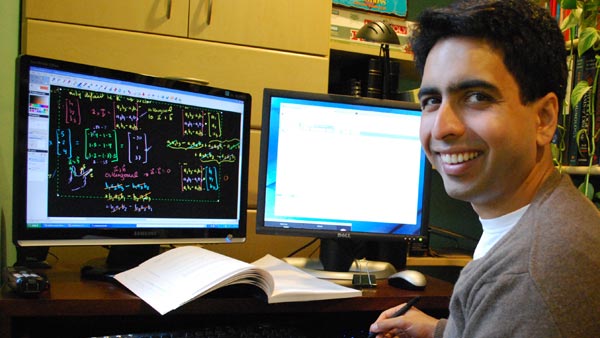For many years futurists have predicted
that education will be revolutionized by computers and the internet.
According to some, that future is already here. For the uninitiated,
let me introduce the Khan Academy, a non-profit organization with a
mission to provide world-class education to everybody in the world –
for free.
The Khan Academy was created in 2006 by
Salman Khan, a graduate of MIT and Harvard Business School. Khan
started out helping his younger cousin when she was struggling with
math by tutoring her first through Yahoo!'s Doodle notepad and then
switched to posting videos on Youtube when other relatives and
friends requested his help. When Khan later realized that his videos
gained increasing interest the concept of the Khan Academy started
forming. His initial educational videos on mathematics was only to be
the beginning and there is now a wide range of subjects available
with everything from physics to biology and art history. The videos
are quite simple in format with Khan himself drawing and writing on
different subjects while also doing a voice-over himself. The Khan
Academy now has over 4000 educational videos, available both on
Youtube and their own homepage, and is constantly growing in both
content and reach.
Revolutionary aspirations
A stated object of the organization is
to change the old paradigm of education and create something better
and Khan himself says that it is theoretically possible to implement
his model in every school in America tomorrow. The way we usually
think of education is the top-down approach where a teacher holds a
”one size fits all lecture” and where students most of the time
sit passively and listen. With Khan Academy in mind this model comes
into question. Considering it is an online resource it is fully
possible for students to utilize the learning material while at home
or even while riding the bus using a smart phone, all for free. In
this way, students can actually get a type of lecture wherever and
whenever they have access to the internet. The student's can simply
create their own login on the Khan Academy homepage and start making
progress on their own.
In practice
When the Khan Academy platform was
introduced at a school in Los Altos, California, it turned
up-side-down the concept that lectures are given in school, and that
some tasks are suitable to do at home. When the lecture material
could be accessed through the platform at home the time in class
could be spent on tasks that were usually set aside for homework. The
model seemed to free up time for the teacher's to only adress
students that got stuck on a specific task, or maybe even better,
made it possible for the teacher to utilize students that have
mastered a specific task so that they can help their peers. The
teacher's have the possibility to monitor every student's progress
individually through their own login and hence know where their help
is most needed.
But what will motivate students to
study on their own?
What Khan Academy has evolved into is
an integrative framework where students can create their own profile
and avatar, get points for completing tasks and earn merit-badges for
skills that they have mastered. These simple measures, inspired by
the world of gaming, can have great incentivizing effects on the
students. It is this twist that seperates the Khan Acedemy from other
types of educational material online – the merging between
education and gaming in order to make learning more fun. In a test
the organization made some slight changes in what types of
merit-badges the student's received and how many points the student's
got for completing certain tasks – something that seemed to have a
real effect on what tasks the student's ended up doing. Teacher's can
use similar measures to motivate student's in an incredibly easy way.
By using computers as a means of
gathering information about the students progress it is also much
easier to rearrange curriculums in order to enhance the learning
process. For instance you could evaluate how quickly a student learns
a set of skills while following one certain path in the system and
compare that with other paths taken by other students. Which paths
are the quickest and most effective? By constantly gathering
information the system can be improved continually in order to
enhance the students learning process. This type of information would
take massive amounts of time to collect if done without
computersystems.
Coupled with the internet the platform
also constitutes a virtual learning space where in theory, the entire
globe can ultimately be connected. It could also mean that the
distinction between teacher and student gets increasingly complicated
where former students can become teacher's or mentor's to other
students. The Khan Academy might be a frontrunner in the educational
sphere in what many people like to call the ”sharing-economy” or
”gift-economy”, in the same way that information is being spread
through peer-2-peer networks online. File-sharing is the obvious
example of sharing for free but also homepages like taskrabbit.com,
couchsurfing.com and zipcar.com could perhaps show us the paradigm of
the future – a paradigm of collaboration and sharing. These new
ways of doing things is of course challenging to many of the
institutions we have in our present society. Will concepts like the
Khan Academy make the teacher obsolete or will their role simply be
different in the future? And how do you create a lasting
business-model in an environment of collaboration and sharing? Time
will have to tell.




No comments:
Post a Comment